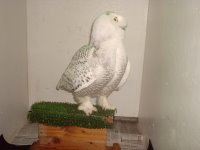 Right now we have 3 snowy owls with us. 2 are at the clinic and the other is at the flight center. The first one pictured just came to us the other day from Izembek National Wildlife Refuge near Cold Harbor, Alaska. It has a badly fractured wing which is non-repairable. It will be amputated later this week and then it will be determined where it goes from here. It is a possible education bird at TLC or placement else where's.
Right now we have 3 snowy owls with us. 2 are at the clinic and the other is at the flight center. The first one pictured just came to us the other day from Izembek National Wildlife Refuge near Cold Harbor, Alaska. It has a badly fractured wing which is non-repairable. It will be amputated later this week and then it will be determined where it goes from here. It is a possible education bird at TLC or placement else where's.The second one pictured is at the flight center being evaluated for release. That could happen very soon.
 The third one pictured was at the flight center. He came to us with a broken wing (see operation to repair it in the photo album on photobucket to your right). However, he is having some issues flying so he was brought back to the clinic to see what's going on.
The third one pictured was at the flight center. He came to us with a broken wing (see operation to repair it in the photo album on photobucket to your right). However, he is having some issues flying so he was brought back to the clinic to see what's going on.This is the most snowy's at one time at our clinic that I know of.

7 comments:
How beautiful they are. What does become of birds that lose a wing? Do you have shelters where they are placed? I have thought it would be a wonderful thing to provide a place for raptors to rehabilitate.
Each case is different. There are a couple of options and with each one the bird and Bird TLC is at the mercy of USF&W and Alaska Fish & Game. If there's room for that specific species (not too many in the program already), Bird TLC can apply for the bird to be added to their education permit. If that's allowed, after training it is taken out in public to be used to educate people on that species of bird. Training is minimal, but protects the bird and the public. Programs are done at schools, federal and state parks, private organizations, church groups, etc. They must be non-commercial gatherings.
If the bird is not allowed to stay with Bird TLC for whatever reason, it's put up for placement. It can be at a zoo or another rehab center that has room for that species or someplace simular. They must already be permited by USF&W and their states equivalent to Alaska Fish & Game.
Who ever the lucky organization is, they are responsible for the birds health and safety for the rest of it's life. Thy must present the bird for a specific number of hours per year. They must follow many strict rules set by USF&W. If they fail to follow these rules, they are subject to forfit their permits.
That's cool. It's always exciting to get a new bird. I did and didn't pass out.
Such beautiful birds--it's sometimes heartbreaking to read your stories, Dave, but I do so admire your work. And it's important to keep people aware. So thanks for all you do.
Thanks Homebird. It is heartbreaking sometimes but I do agree that we must keep people informed. I'm just a small part of a lot of volunteers and a professional staff. They all do a heck of a job!
keeping all of these beautiful owls in good thoughts for a full recovery. I'm volunteering at a rehab show next month and while it's thrilling to be so close to a wild raptor/owl, it's also sad.. they never loose the urge to fly and be free. But thank goodness many of them care enough to make them as comfortable as possible. (Yourself included)
You lucky girl. Tell me more about the show when it's over next month.
Post a Comment